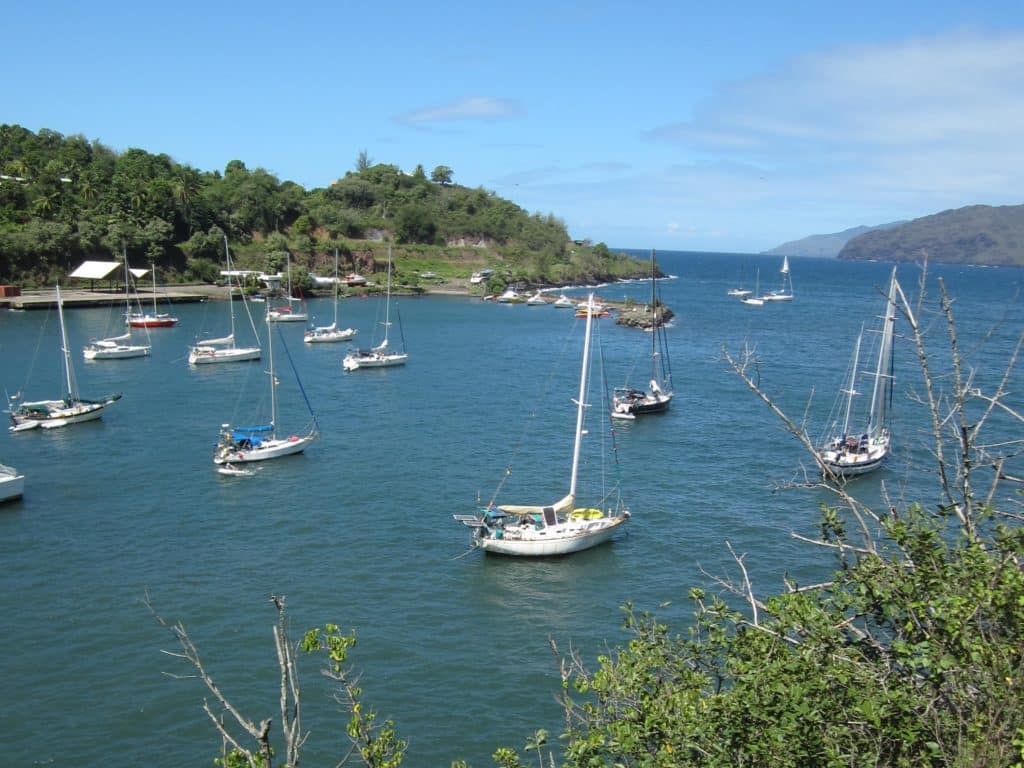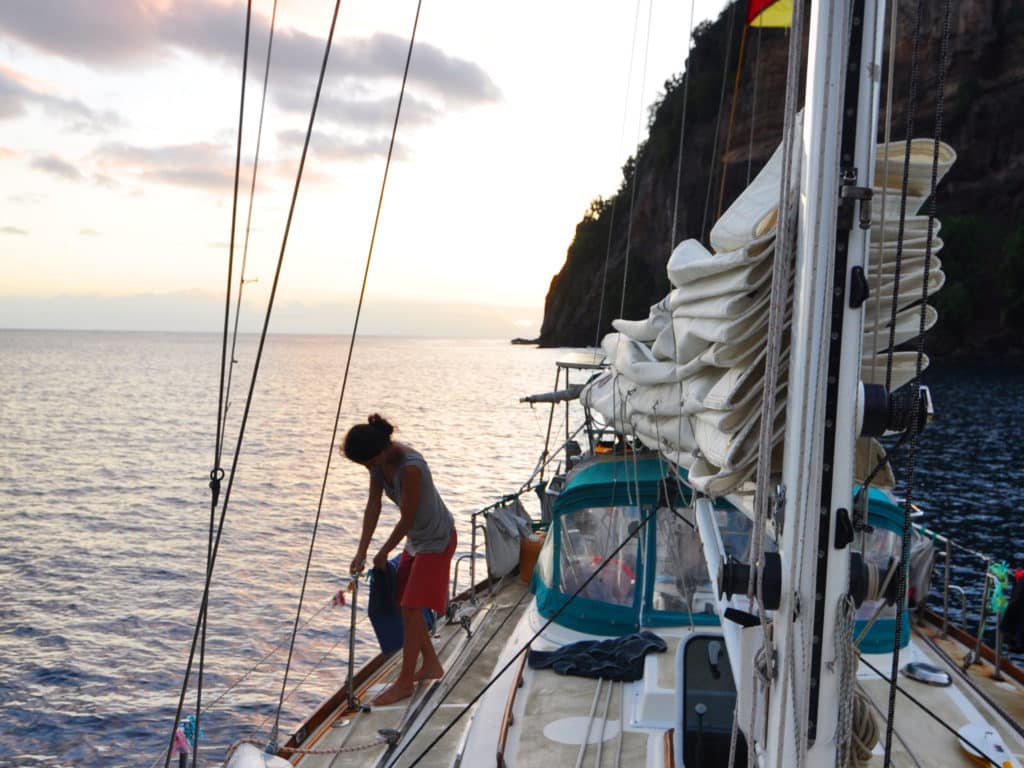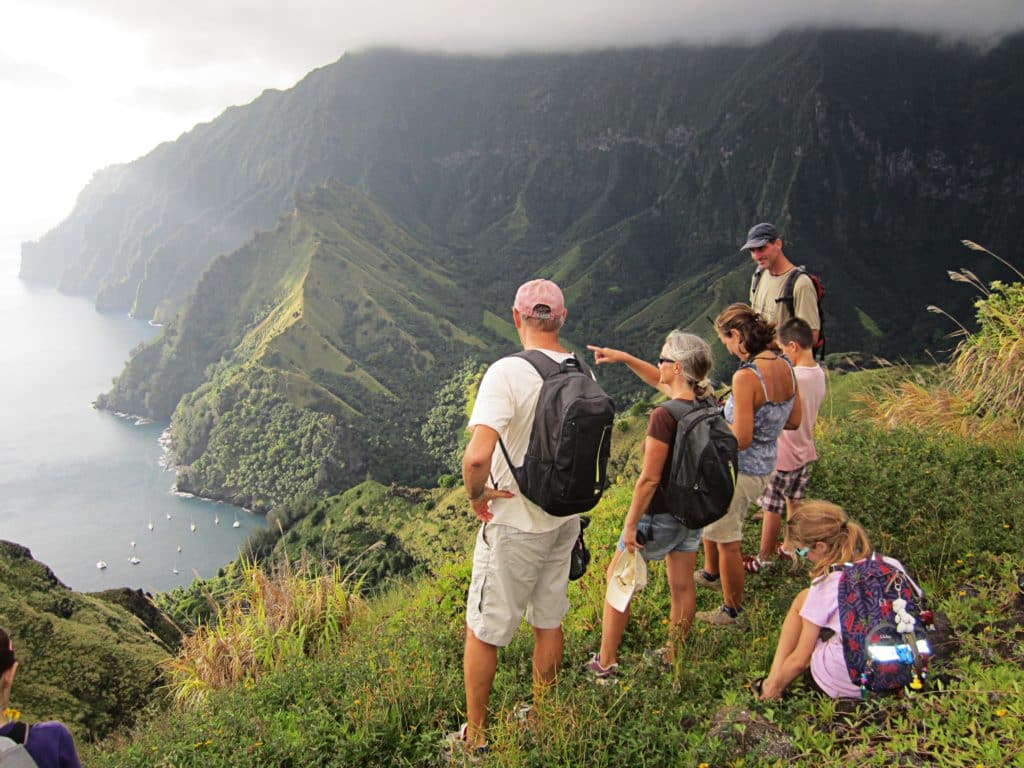
The Marquesas
Twenty-six days after sailing Del Viento away from the arid tip of Mexico’s Baja Peninsula, we dropped our 66-pound Bruce anchor and 300 feet of chain into 140 feet of water. It was the end of the longest passage we’d ever made. I’d not slept well the night before, and upon making landfall, I tried to record my first thoughts and impressions. I detected jasmine and gardenia and an earthy must in the air. I worried we’d never retrieve our primary anchor if it got stuck down there. Then, I thought of penises.
We’d sailed 3,000 miles to reach this place, a narrow anchorage cut into the small island of Fatu Hiva, smack dab in the middle of the Pacific Ocean. It’s one of a group of 15 islands that the Polynesians who settled here around A.D. 1200 named Te Fenua Enata, meaning the Land of Men. Locals still use this name, though the rest of the world calls these islands the Marquesas, after the patron of a 16th-century Spanish explorer. But in this bay in particular, where I was now recording my thoughts and impressions, the earliest residents thoughtfully considered the phallic spires of black basalt rising from the head of the bay and declared it the Bay of Penises. It was a place name befitting the Land of Men, but it made early missionaries uncomfortable, and they quickly corrected things. Today the French call this storied landfall Baie des Vierges, or Bay of Virgins.
Sounds exotic, doesn’t it? It definitely stirs thoughts of a South Pacific paradise, rather than simply the first waypoint on a trans-Pacific crossing, as it is for most. Had I been given the task of naming this place upon arrival, I might have gone with Baie de Paradis, but I am no more to be trusted than the missionaries. After all, any port reached after 26 days at sea can seem to a sailor like paradise. So you have to wonder: Is this the reason for the superlatives often used to characterize the Bay of Virgins and other Marquesas landfalls?
The Marquesas are among the youngest of the South Pacific archipelagos. Not enough geologic time has passed for fringing coral reefs to have formed. Compared to the tranquil, turquoise lagoons of the nearby Tuamotus and Society Islands, the water off the Marquesas is rough, deep and murky. The snorkeling, diving and surfing here are downright unremarkable. Because these islands rise from the depths, raw and exposed to ocean swells that travel thousands of miles to crash on rocky shores, even the best anchorages on the leeward sides are plagued by refracted waves that cause boats to roll uncomfortably. Dinghy landings are often either in surf or at surge-inflicted, inflatable-eating quays composed of jagged rock, rough concrete and rusted metal. When available, Internet service is slower than the average cruising boat, and the imported food seems to have been priced by a high-end retailer. Still, we spent six weeks exploring these islands. We wished we had six months.
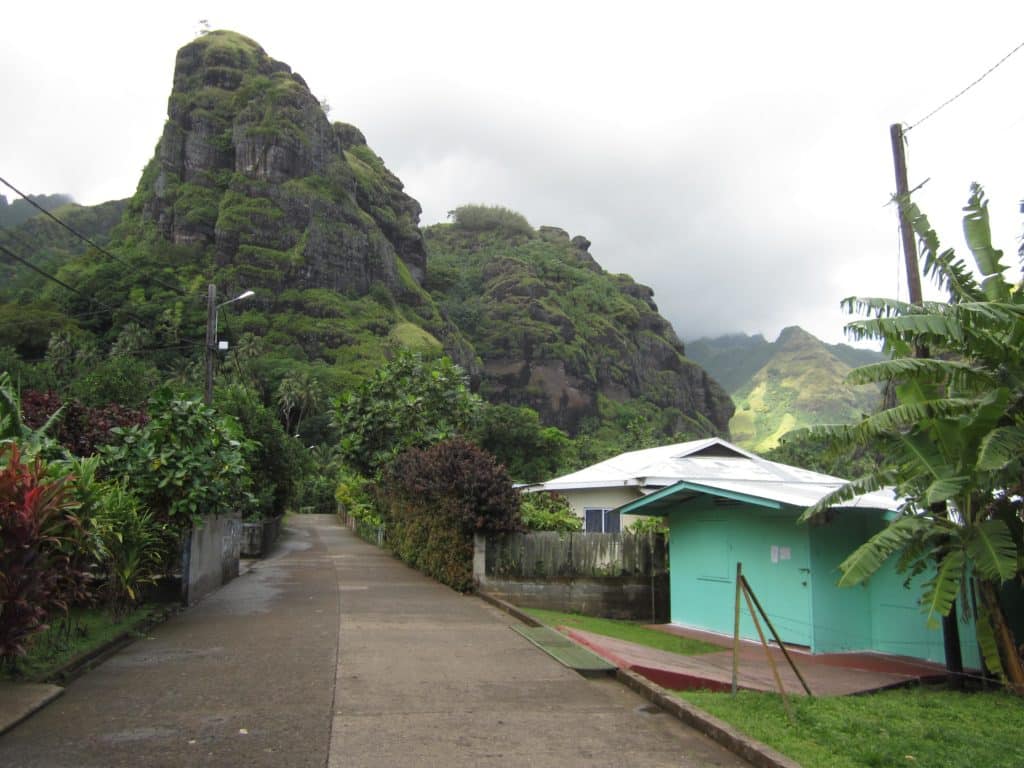
Taste of the Cruising Life
On the windward side of Fatu Hiva, the trade winds hit a tall ridge and pushed upward to form the moisture-heavy clouds that spilled down toward us as we dropped anchor. A rainbow arced across the sky. The topography of these young islands reflects the dawn of time; the exquisite drama of the islands’ violent, volcanic origins has not yet been smoothed and worn. The mountainous backdrops demanded that I set a new bar for using words like “steep” and “jagged.” At the head of the V-shaped Bay of Virgins is a rocky beach fringed with coconut palms and mountains bearded in deep green, reaching steeply for more than 2,000 feet.
I looked around at the boats anchored nearby. Nearly all were French-, Dutch-, or Australian-flagged. Most had stalks of green bananas hanging from the rigging and cockpit hammocks bulging with fruit. I’ve seen thousands of boats in all kinds of anchorages, but this detail, combined with the backdrop, echoed the images I’ve returned to for decades, the ones of Wanderer or Dove or Joshua anchored in a similar setting, the images that for me define cruising. I was eager to launch our dinghy, go ashore and get my own stalk of bananas to hang in Del Viento’s rigging. Maybe I’d bring a machete.
Among the Marquesan islands, Fatu Hiva is remote and sparsely populated; about 600 people are spread across three villages. There is no airport on the island. We’d dropped anchor in front of Hana Vave, the village at the head of the Bay of Virgins.
Upon landing, we received a Kafkaesque welcoming — that is to say, a jarring and disorienting one, especially for wide-eyed sailors stepping ashore for the first time in nearly a month. The tiny quay was empty except for a big, heavyset boy in swim trunks who barked at us sternly and urgently in Marquesan. We smiled and said hello. He pointed and grew increasingly agitated at our inability to understand him. “Does he want us to move our dinghy?” my wife, Windy, asked.
The boy began grunting. Then he began poking his index finger at Windy’s shoulder. I began to sense he had mental health issues. Salvation appeared in the form of a large woman walking toward us. She had a green grapefruit in her hand. “His mom is coming,” I said to Windy.
I greeted the woman. She smiled broadly. I waited for her to rein in her son a bit. She didn’t seem to notice him. She locked her stare on me, her smile fixed, like a young girl in love. The boy poked us and grunted. Then we found ourselves in negotiations to buy her grapefruit. She thrust it at us. The boy was suddenly her English–speaking agent, translating numbers for her, poking the grapefruit. She only smiled and nodded. Now I began to sense she had mental health issues. “Let’s go back to the boat,” I said.
“No!” came the chorus from our daughters.
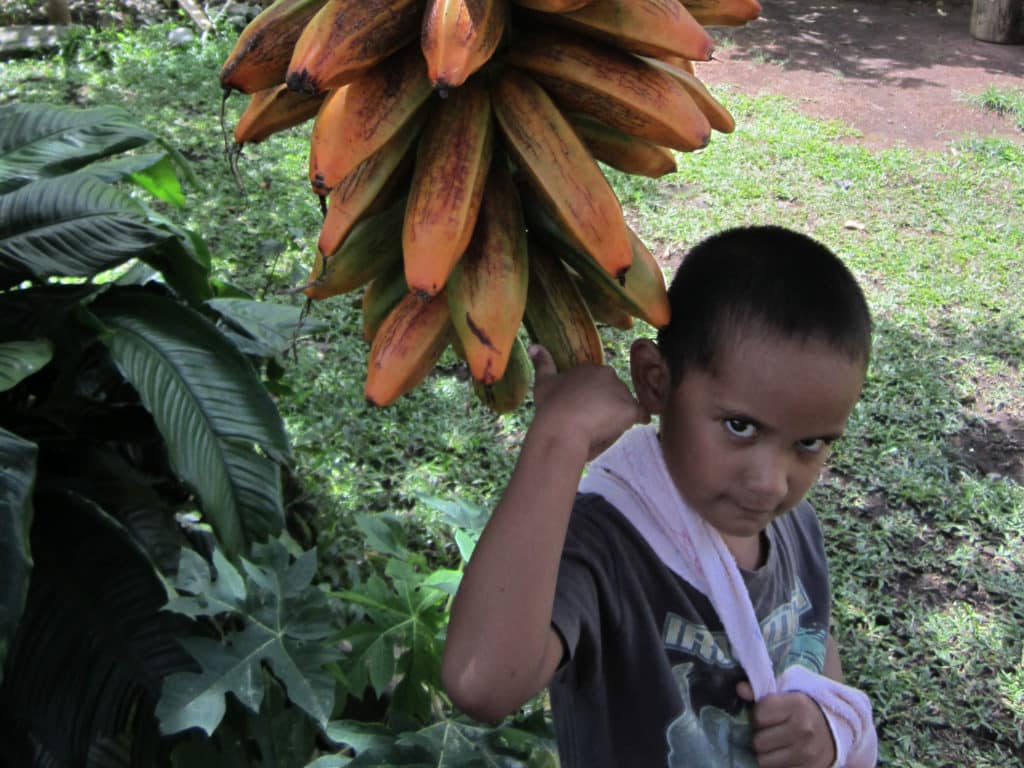
We treaded lightly with our girls in tow, wandering, taken by the smell of flowers and marveling at the trees and plants hung heavy with fruit. Our reception -began to make sense. Who else did we expect to stand at the waterfront and greet us? There were 20 other boats in the anchorage, 20 before that, and 20 before that — we were just another dinghy-load of visitors in a season–long procession. The people of -Hana Vave have no real need for visiting voyagers, and we’d long ago ceased to be the curiosity that early cruisers like Sterling Hayden, Robin Lee Graham and -Bernard Moitessier presented.
There was no litter anywhere. There were no signs either, and we walked up the narrow concrete road past a string of residences, a church, a school, a soccer field and a small but immaculate magasin offering a food selection similar to a 7-Eleven back home. Houses built by their owners stood on defined, ordered lots abutting one another, each with its own satellite dish. We offered smiles and a “ka oha” — hello in Southern Marquesan — to the few people we saw on a quiet Monday morning.
A woman in her yard waved us over. She said something in French. We looked at each other. She repeated herself, slowly. We heard the word échange, and she pointed to the grapefruit and mandarin -oranges hanging from the trees in her yard. Our Mexican citrus was long gone and -sorely missed. She motioned at a pile of five coconuts arranged in a pyramid. She held up a jar of viscous amber liquid and pointed to the humming hives at the side of her house. Then she pointed to the Teva sandals on our feet and said the word “corde,” while I flipped through our pocket-size French-English dictionary — corde (noun): rope.
We shook our heads no, we didn’t have shoes to spare, but yes, we had corde. I fumbled again with the dictionary and -promised we’d be back in two hours. We waved goodbye — au revoir! — and made our way, greeting other residents, even arranging a second trade. Then we dinghied back out to Del Viento, gathered things to trade and returned ashore, my backpack filled with an old halyard, clothing our girls had outgrown, and some of the children’s art supplies we’d stocked up on before leaving Mexico.
During the 10 days we spent in Hana Vave, our daily adventures took us about the island and our fruit hammock grew to bulging. We swam with manta rays next to our boat, we hiked to a waterfall that stretched to the sky, we made friends, and we learned we all love grapefruit. When we finally bid adieu and set sail on an overnight passage for the Marquesan island of Hiva Oa, we did so with a massive stalk of green bananas hanging in our rigging.
